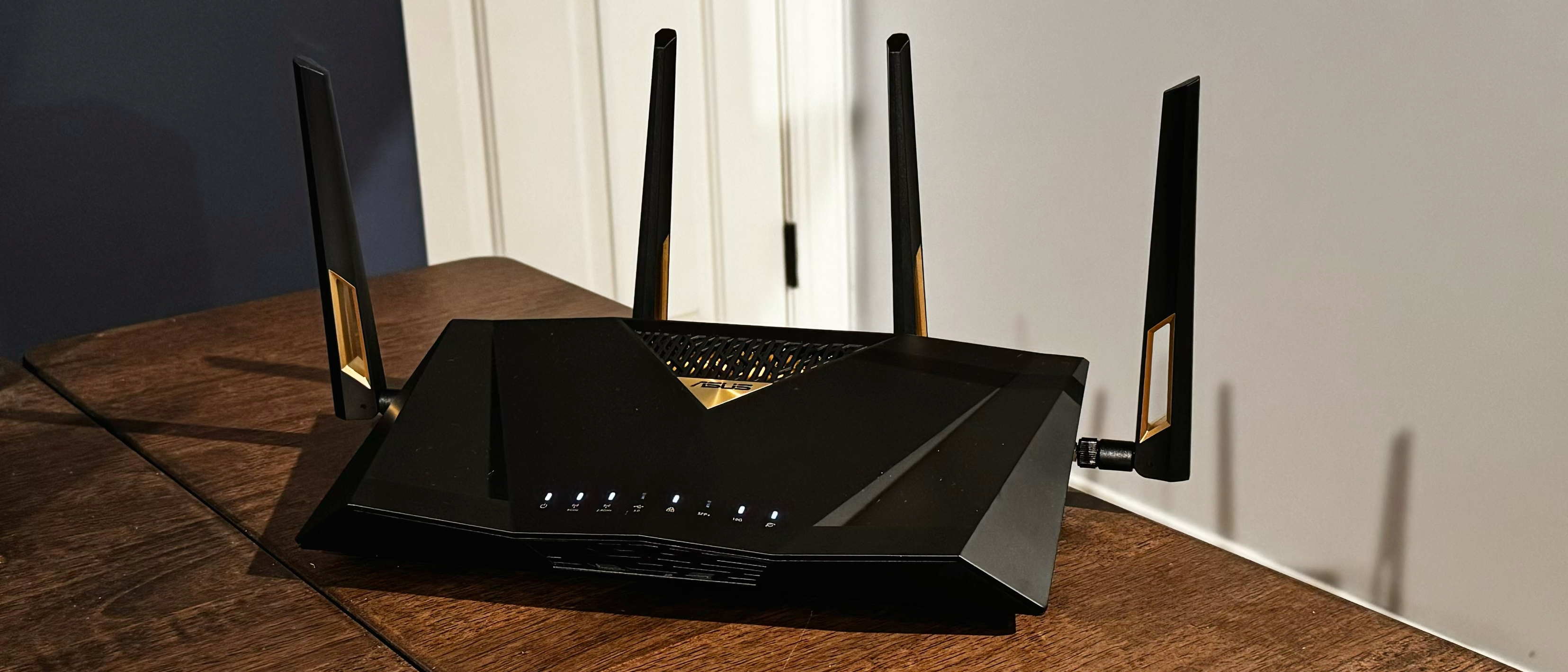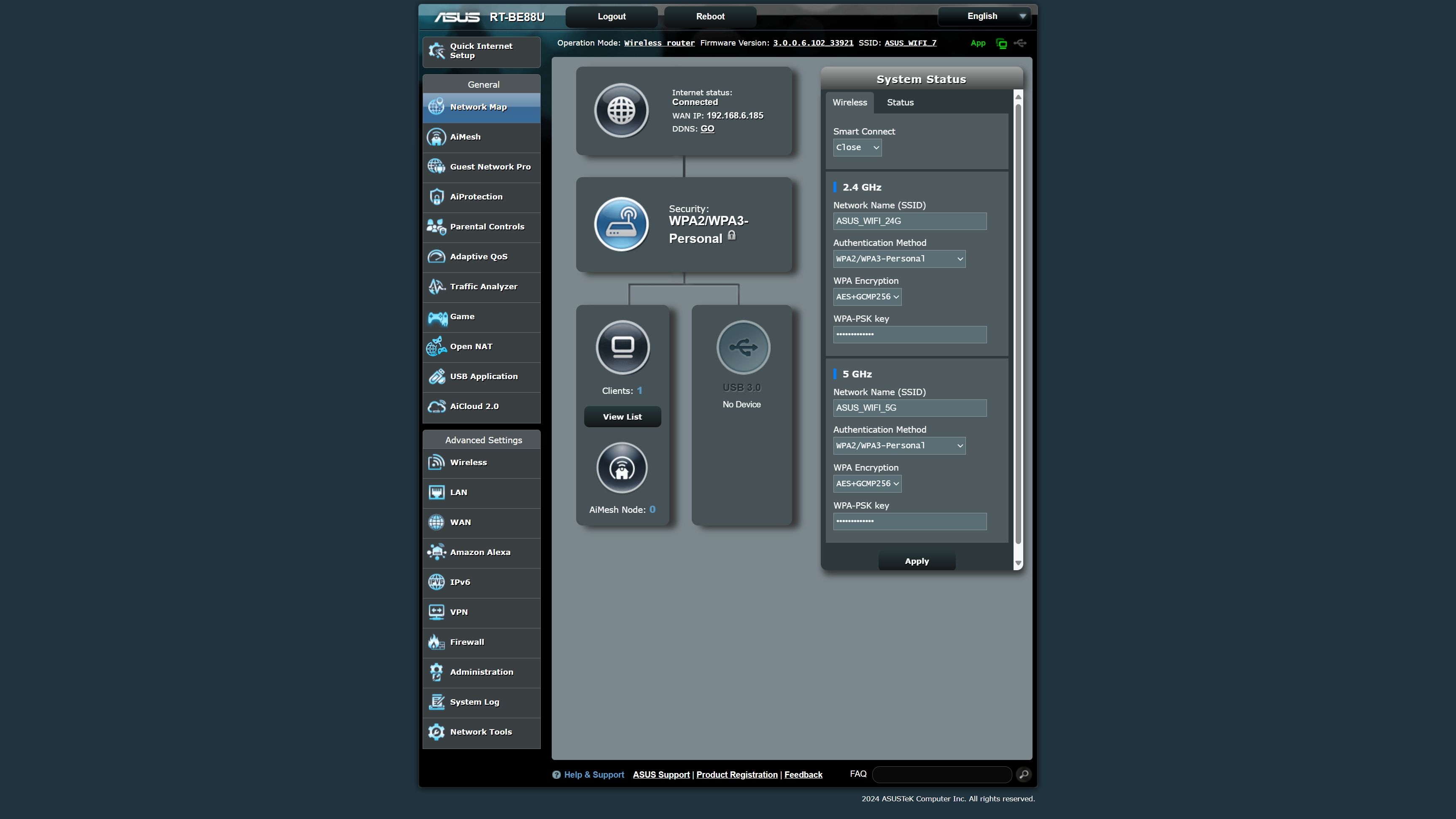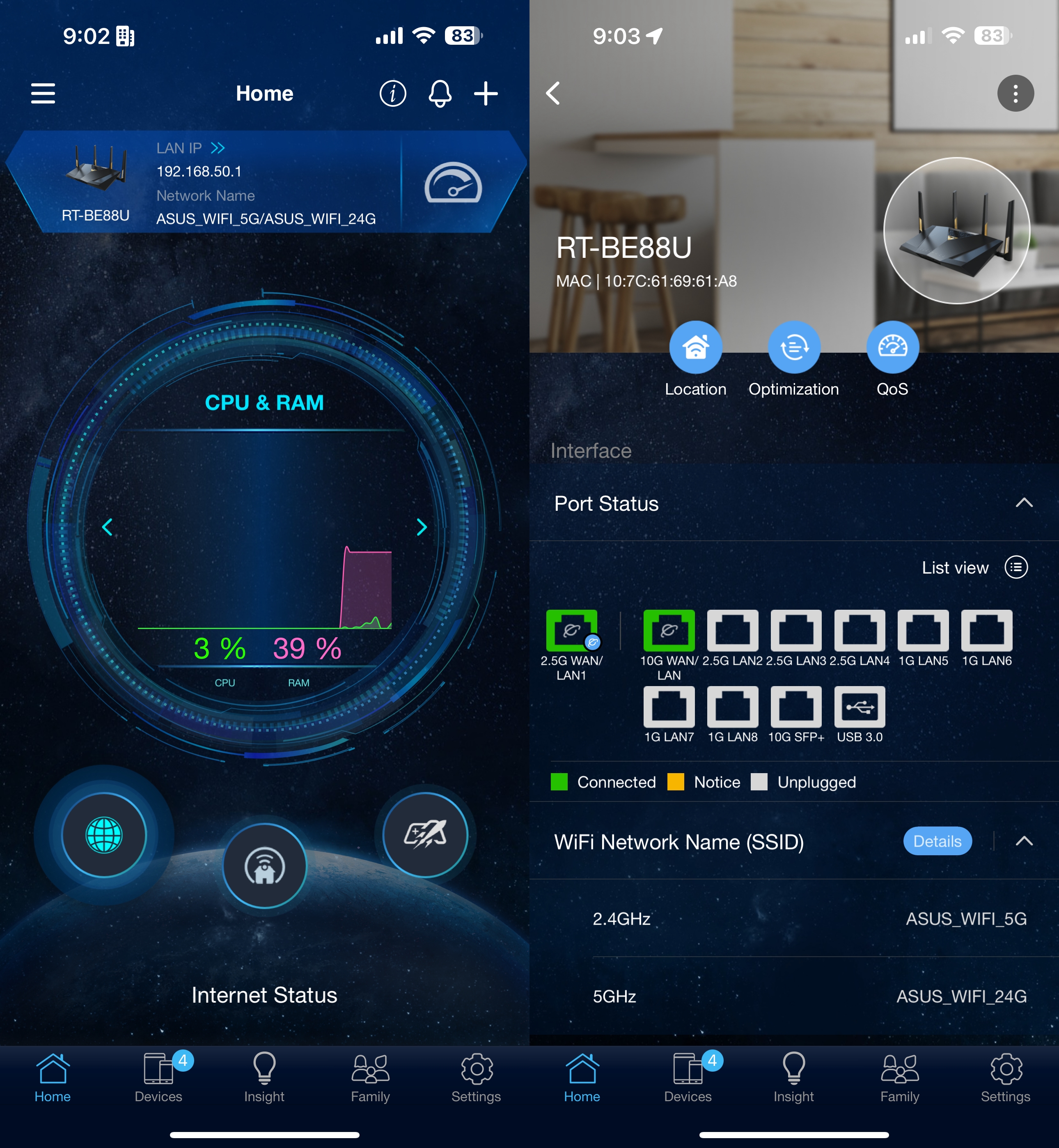Tom's Hardware Verdict
Wi-Fi 7 on a budget means that you miss out on breakneck wireless speeds.
Pros
- +
Value pricing
- +
Tremendous amount of LAN ports
- +
Strong performance on the 5 GHz band
- +
Still supports MLO and 4K-QAM
Cons
- -
Lacks 6 GHz band
- -
Can’t take advantage of all of Wi-Fi 7’s features
Why you can trust Tom's Hardware
What makes a Wi-Fi 7 router? For those familiar with the latest wireless standard, that typically means that the router comes with three bands: 2.4 GHz, 5 GHz, and 6 GHz. Concerning the 6 GHz band, we get 320 MHz channeling to improve overall network performance. However, in some regions of the world, the 6 GHz band isn't licensed for commercial use, and most consumers simply don't have an abundance of 6 GHz gear.
To address these market factors, Asus introduced the RT-BE88U, a dual-band Wi-Fi 7 router without a 6 GHz channel. That means you won't find the super-fast speeds afforded by the 6 GHz band, but you do get to leverage other Wi-Fi 7 technologies like Multi-Link Operation (MLO) and 4K-QAM.
One of the added benefits of the dual-band setup is that the RT-BE88U is much cheaper than other Wi-Fi 7 routers, with an MSRP of $349.99. That’s a good price for the new standard, but is this model good enough to compete with the best routers?
Design of the Asus RT-BE88U Router
The RT-BE88U adopts the traditional, low-profile design we’re accustomed to seeing with dual-band routers. The router features four poseable antennae: two of which sprout from the side rear of the body, while two more are positioned on the rear, flanking the 2.5 GbE and 1 Gbe ports. The RT-BE88U has an impressive array of ports, including one 10 Gbps WAN/LAN, one 10 Gbps SFP+, one 2.5 Gbps WAN/LAN, three 2.5 Gbps LAN, and four 1 Gbps LAN.
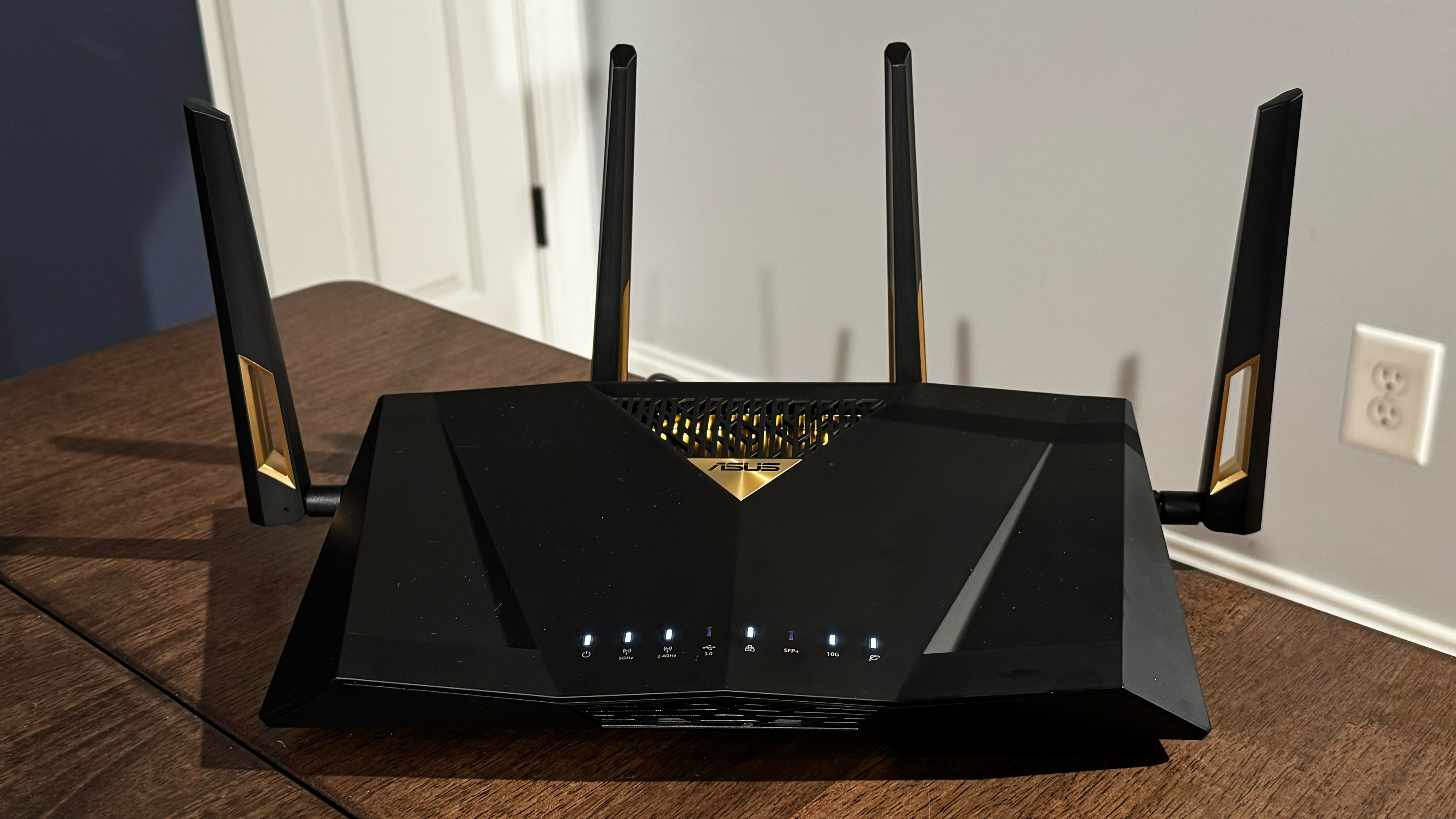
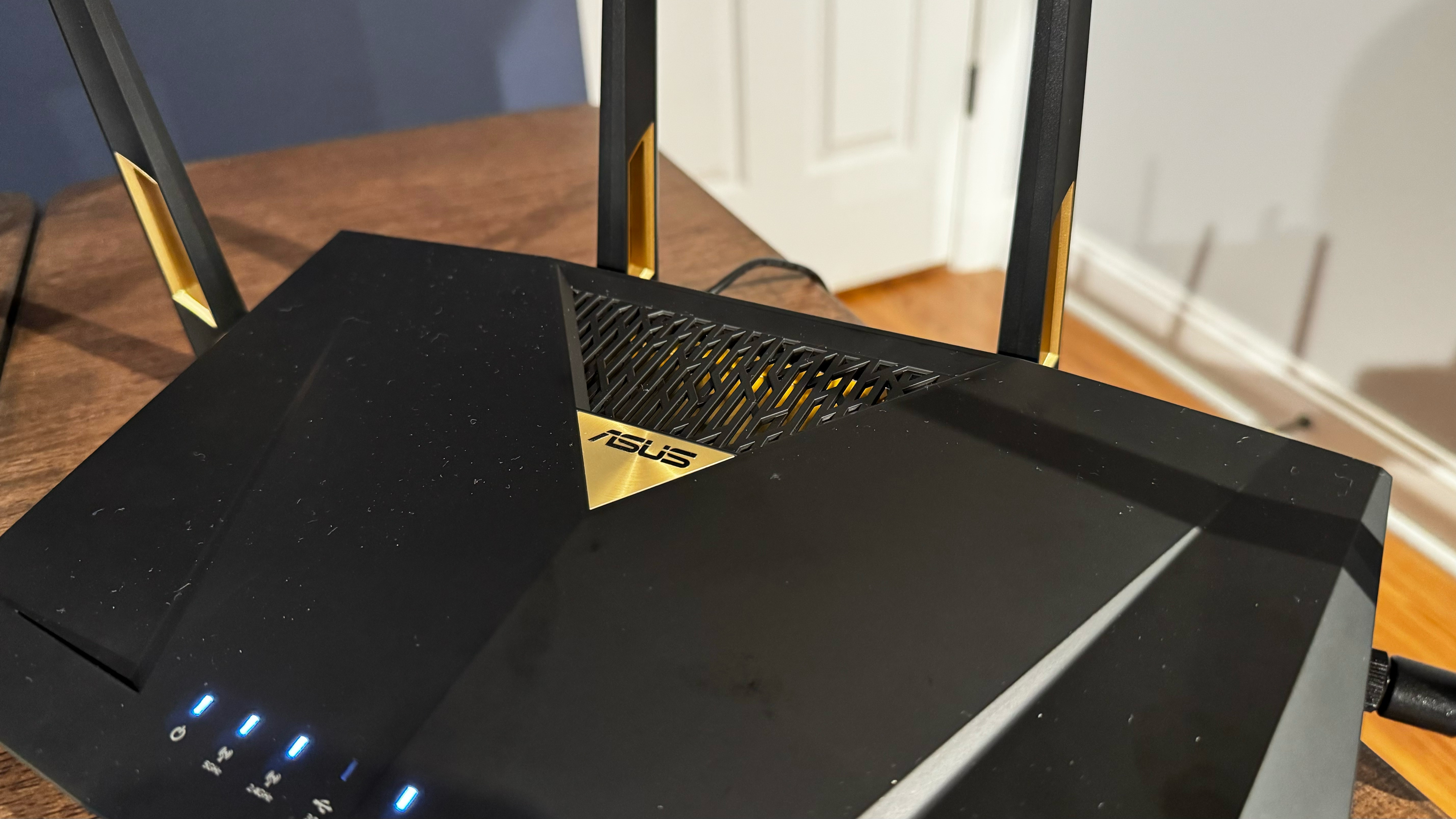

Also on the back of the router is a single USB 3.0 port (which is for adding external storage or enabling 4G/5G smartphone tethering feature), a WPS button, a reset button, a barrel-style power port, and a power button. An array of LEDs is located at the front of the router (WAN, 10G WAN, 10G SFP+, LAN, USB, 2.4 GHz, 5 GHz, Power).
Asus RT-BE88U Router Specifications
| Wi-Fi Standard | Wi-Fi 7 |
| Wi-Fi Bands | 2.4-GHz: 4x4 (Tx/Rx) |
| Row 2 - Cell 0 | 5-GHz: 4x4 (Tx/Rx) |
| CPU | 2.6 GHz quad-core processor |
| Memory | 2GB RAM, 256 MB Flash |
| Wi-Fi Coverage | 3,000 square feet |
| Ports | 1 x 10Gbps for WAN/LAN, 1 x 10Gbps SFP+ for WAN, 1 x 2.5Gbps for WAN/LAN, 3 x 2.5 Gbps for LAN, 4 x RJ45 10/100/1000Mbps for WAN/LAN, USB 3.2 Gen1 x1 |
Setting up the Asus RT-BE88U Router
To configure the RT-BE88U, I first addressed all the physical connections needed. I plugged in power to the router, connected my modem to the 2.5 GbE WAN/LAN port, and then connected the 10 GbE port on my Windows 11 server to the 10 GbE WAN/LAN port on the RT-BE88U.
Like other Asus routers, the RT-BE88U is very easy to get up and running using either the web interface or the Asus app. I prefer the web interface because it's easier to type/navigate using my keyboard and mouse than my smartphone. I pointed the Microsoft Edge browser to Asuslogin.com and then was asked to create a new wireless SSID for the combined 2.4 GHz and 5 GHz bands, along with a strong password. The setup program also automatically creates a guest network using your primary SSID name with the "-IOT" suffix for your IOT device. I finally needed to create a username and password for the router.
Get Tom's Hardware's best news and in-depth reviews, straight to your inbox.
With those steps out of the way, I was presented with the familiar AsusWRT 5.0 homepage/status page for the RT-BE88U.
Asus RT-BE88U Software
The RT-BE88U runs AsusWRT 5.0 firmware, which has been standardized across Asus’ Wi-Fi 7 routers. Although it skimps on one of the biggest tent poles of the Wi-Fi 7 standard — the 6 GHz band — RT-BE88U does support other enhancements such as Mult-Link Operation (MLO) and 4K-QAM.
Simultaneous MLO allows the router to combine two bands (i.e., 2.4 GHz and 5 GHz) to increase peak throughput speeds and lower latency. Alternating MLO enables a client to dynamically switch between multiple bands based on available bandwidth, potential wireless interference, and traffic conditions. The MLO feature is enabled from the main Wireless menu under Advanced Settings. You’ll see it under the MLO tab.
4K-QAM allows for a 20 percent uplift in data rates compared to 1024-QAM, as utilized with Wi-Fi 6 due to better spectrum efficiency.
The rest of the web user interface is nearly identical to the one previously seen on the RT-BE96U. The RT-BE88U supports virtual SSIDs, like the aforementioned IoT network. There are also familiar standbys like the Guest Network and the Kid's Network, which allow you to cater access specifically to minors with parental controls.
One of my favorite features, which also appears on the RT-BE88U, is the ability to use the USB 3.0 port to tether internet from a smartphone. In other words, you can use an Android or iOS smartphone as a "modem" for your router in the event of a major outage by your internet service provider. The smartphone tethering options are accessible from the USB Application menu.
I’ll note that the Asus Router smartphone app is nearly as feature-filled as the web interface, but it was harder to find specific features (though there is an option to access the traditional web interface directly from within the app). However, the app is versatile enough to support your network without having to reach for your laptop, and it supports remote connections for logging in to your router when you are away from home.
Asus RT-BE88U Performance
I perform my router tests from my home office, located upstairs, near the center of my home. My wireless client, an Acer Swift Edge 16 with a Qualcomm FastConnect 7800 Wi-Fi 7 wireless adapter, connects to the RT-BE88U at distances of six feet and 25 feet. Ping and iPerf3 tests are conducted with uncongested and congested traffic to provide both best-case and worst-case scenarios for network performance.
Congested testing involves bombarding the wireless network with six 4K YouTube streams from six wireless clients. A seventh client downloads 63 gigabytes of game files from my roughly 600 Mbps internet connection to add to the chaos.
Wi-Fi throughput is conducted with iPerf 3.16, while ping tests leverage the built-in tool included with Windows 11. A desktop with a 10 GbE network adapter integrated into the motherboard is used as a server, connected to the 10 GbE LAN port on the RT-BE88U.
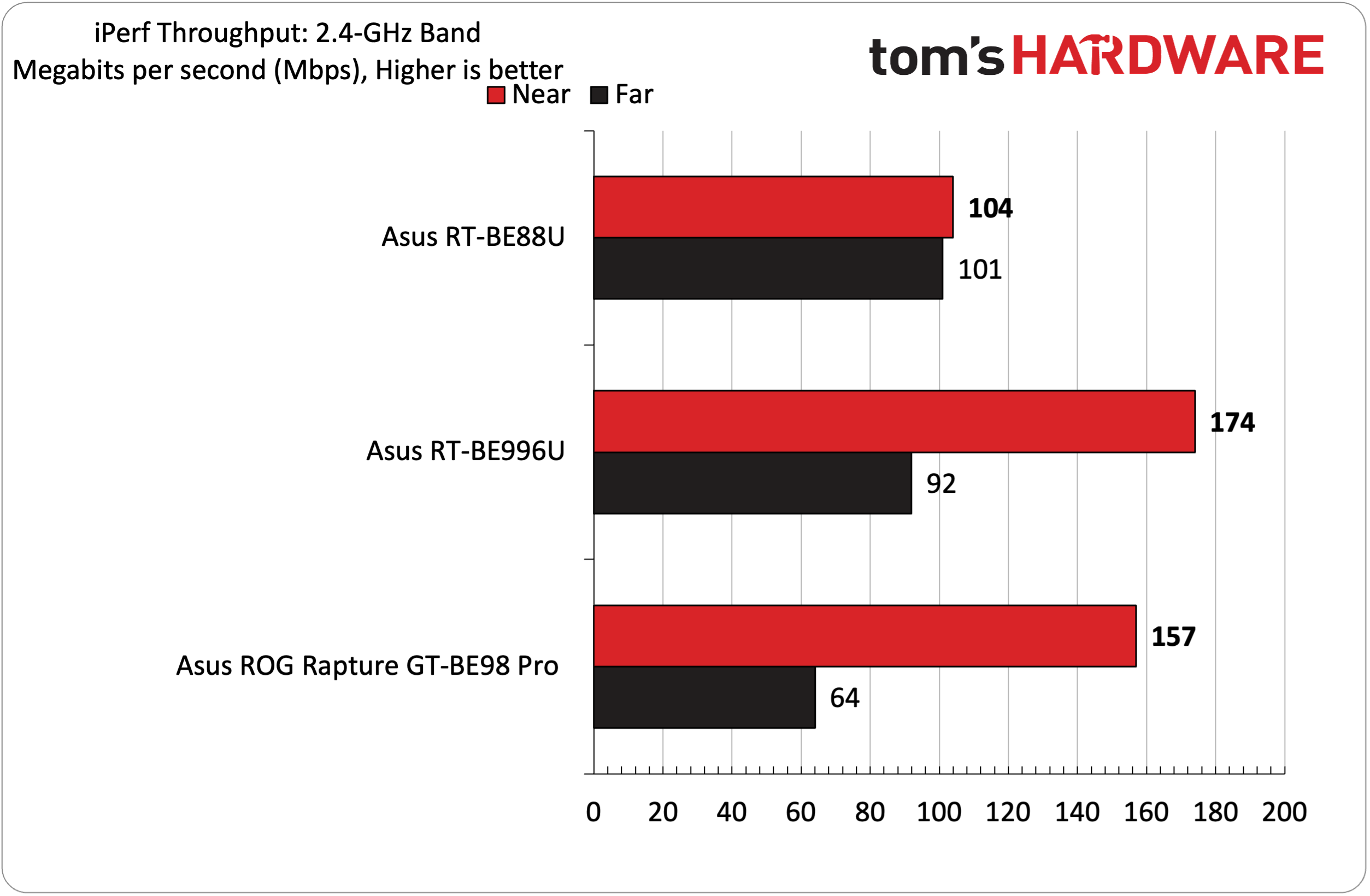
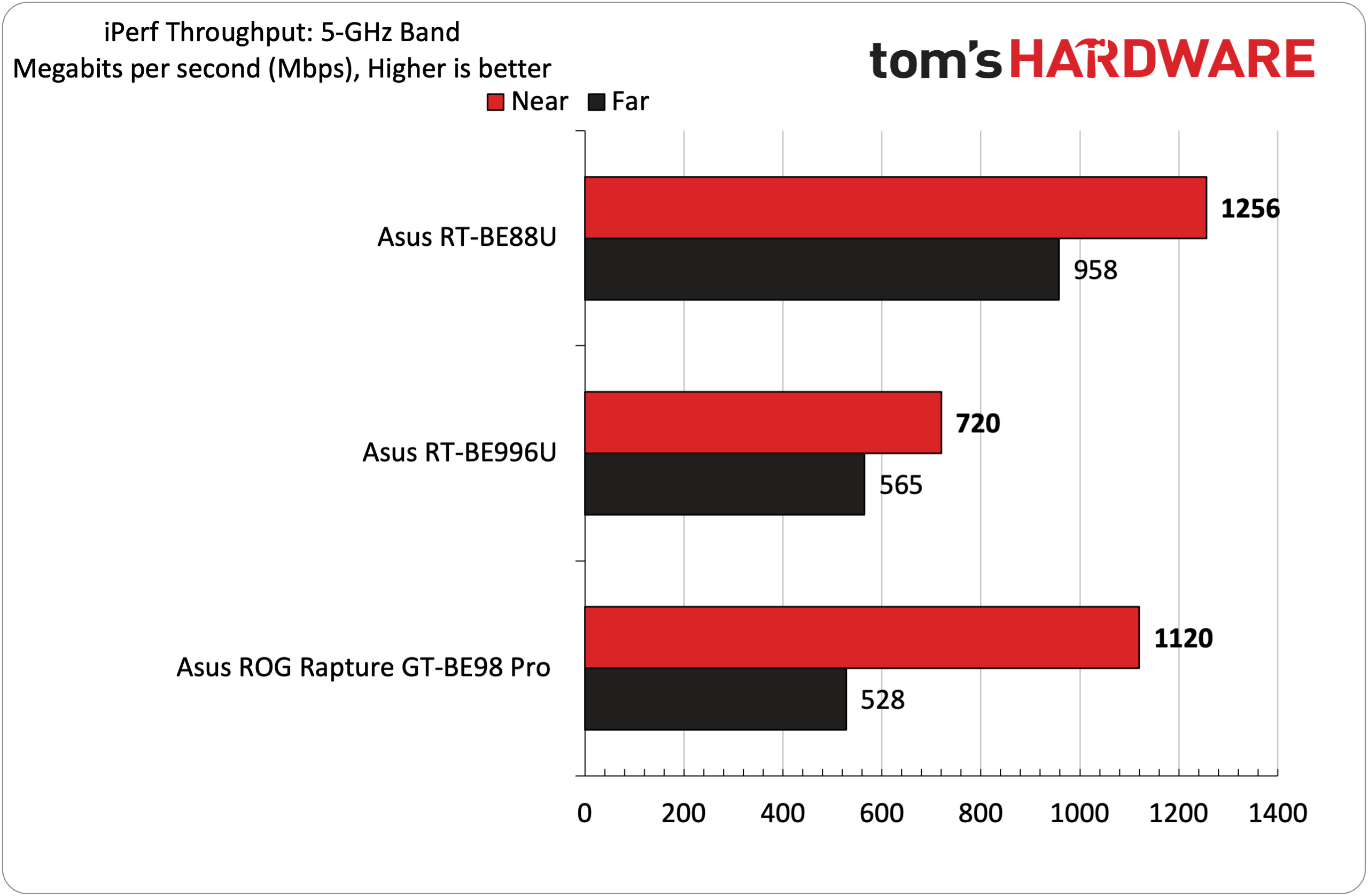
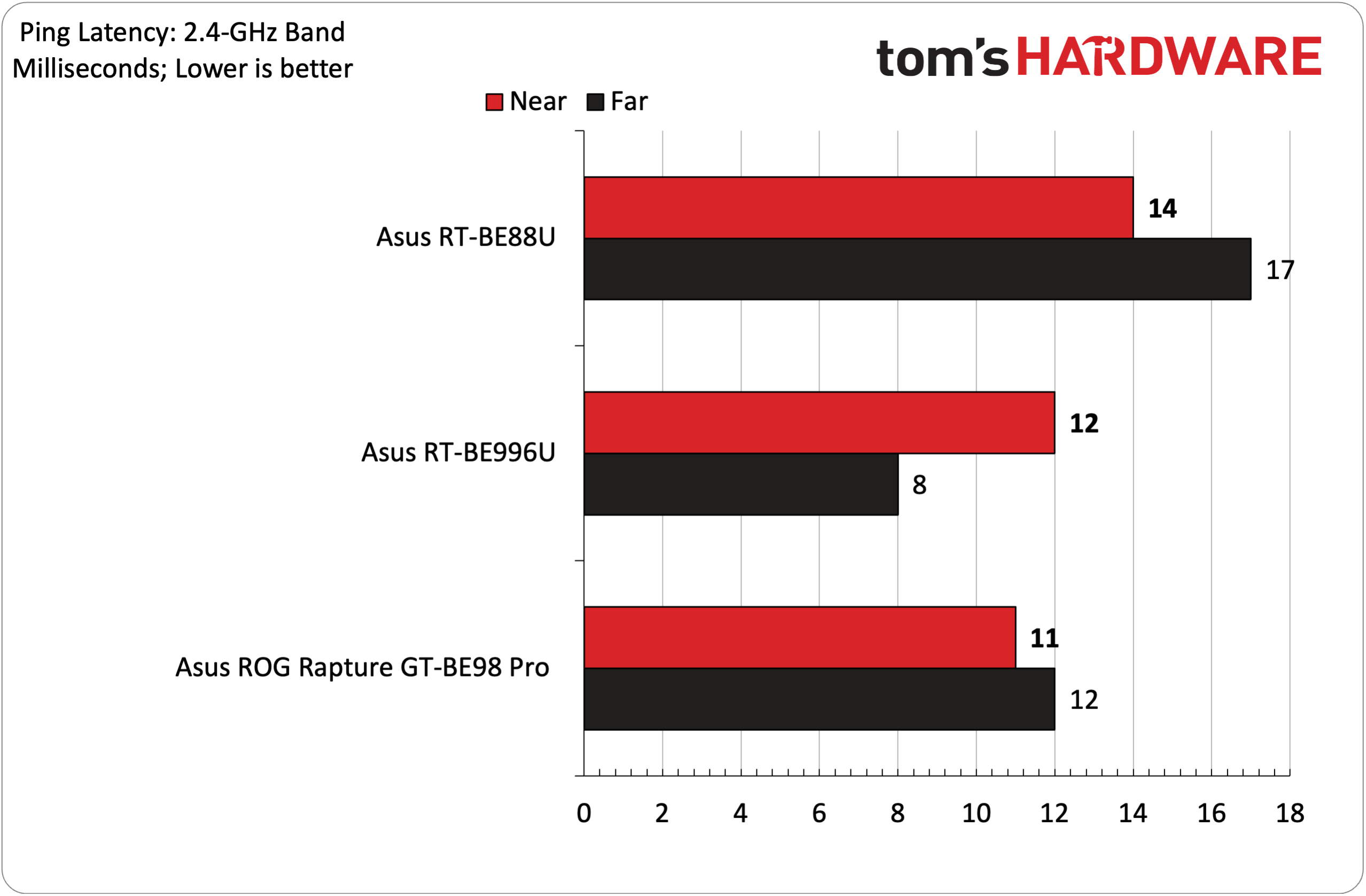
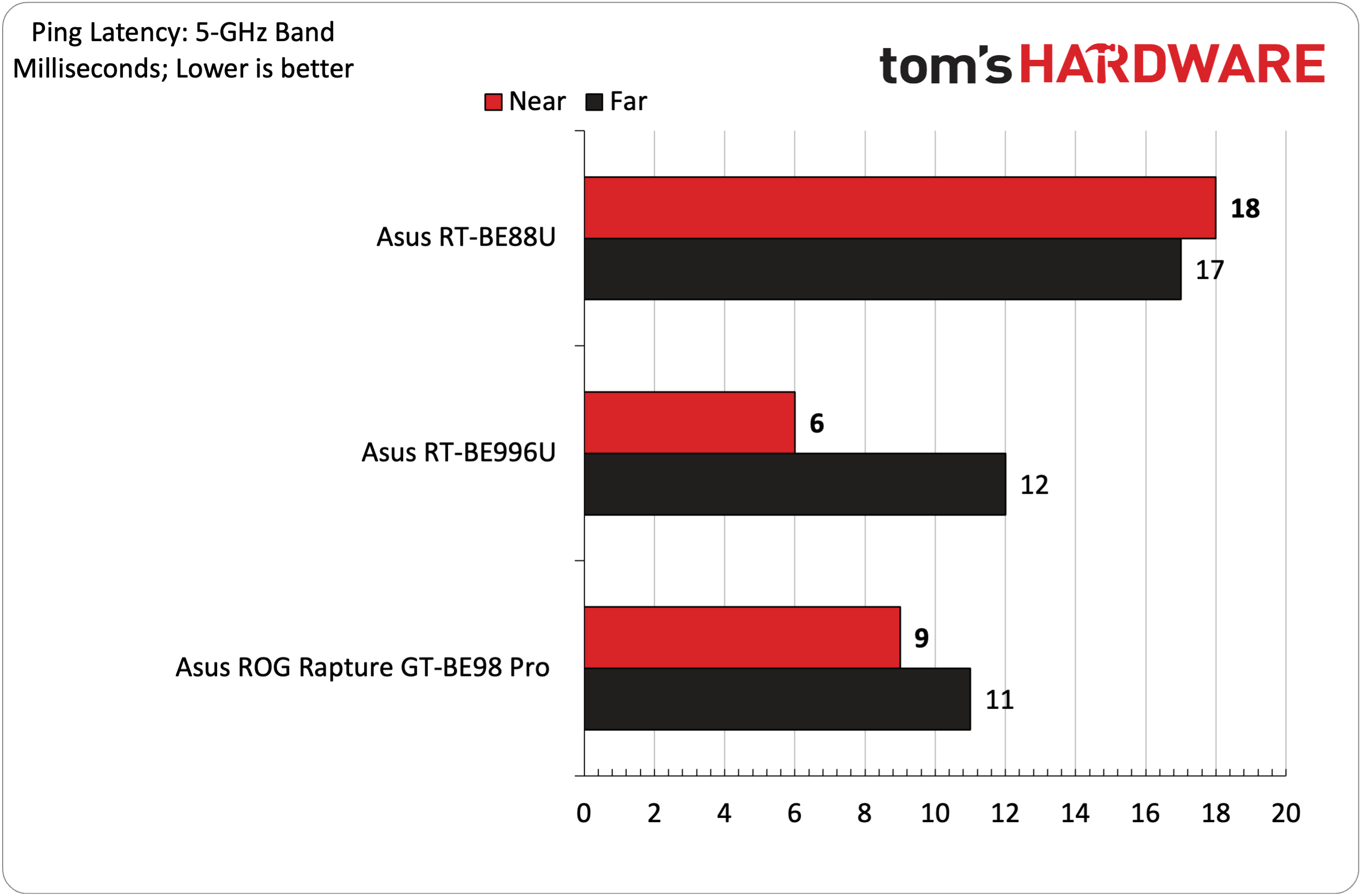
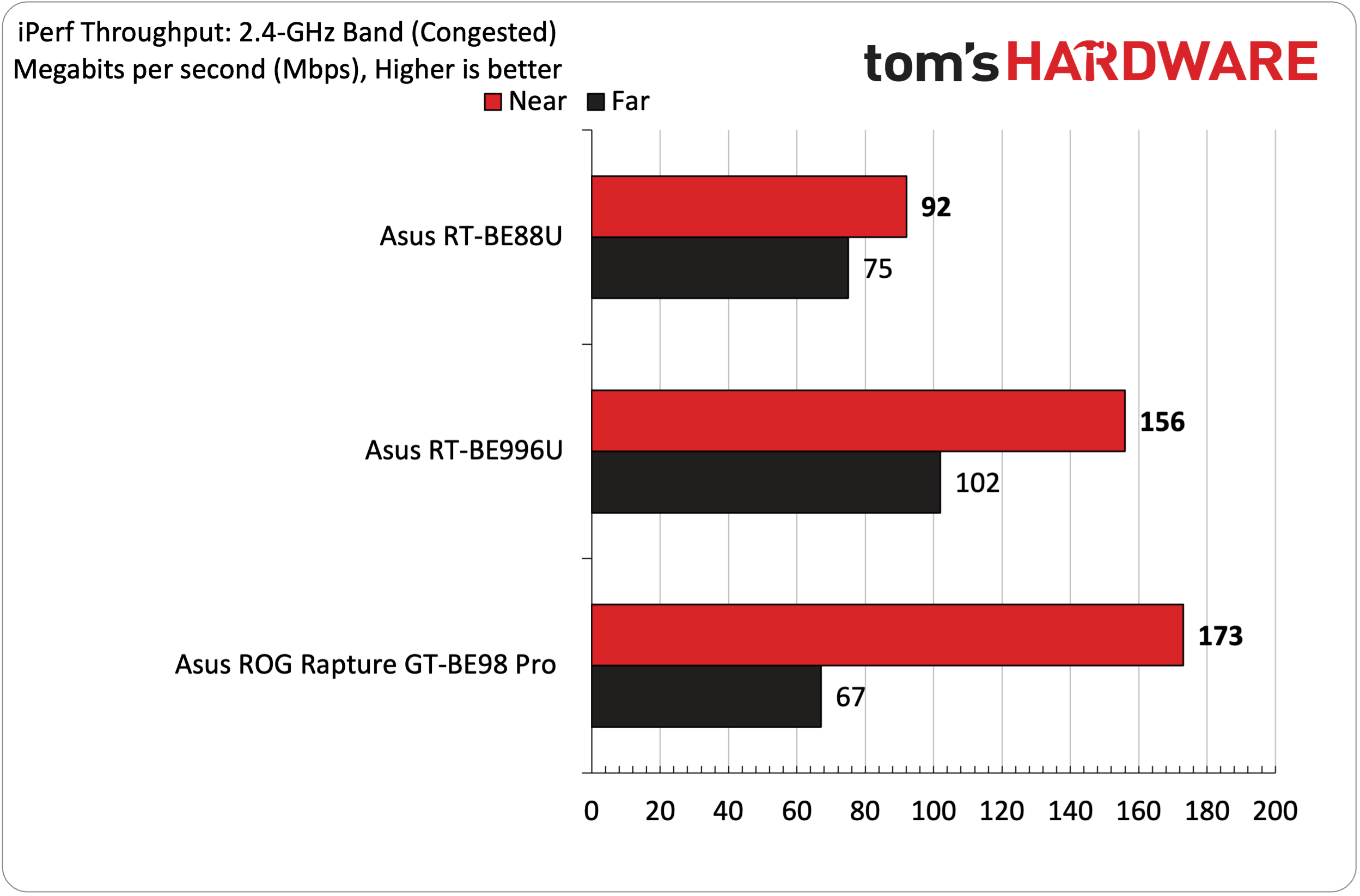
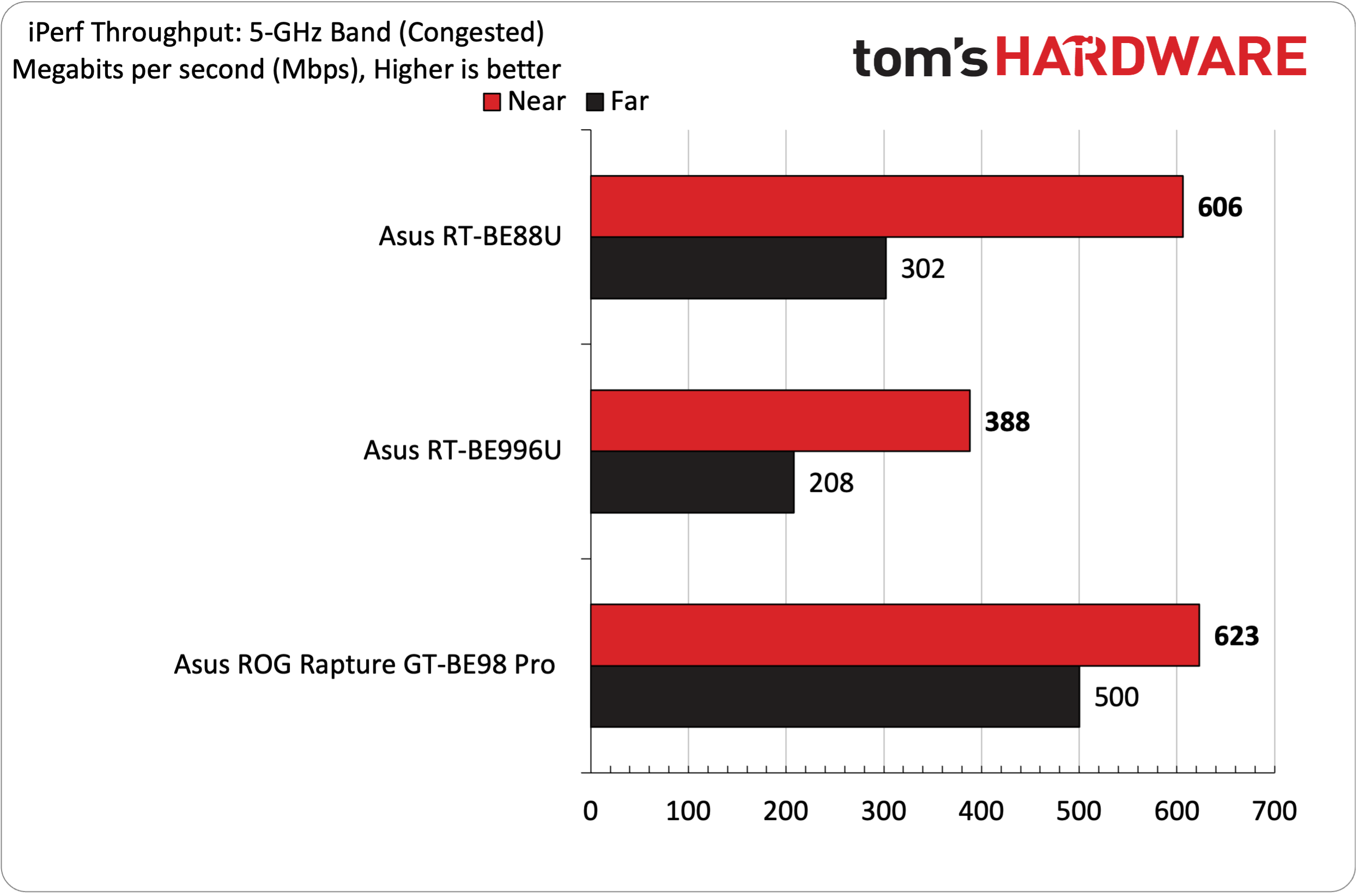
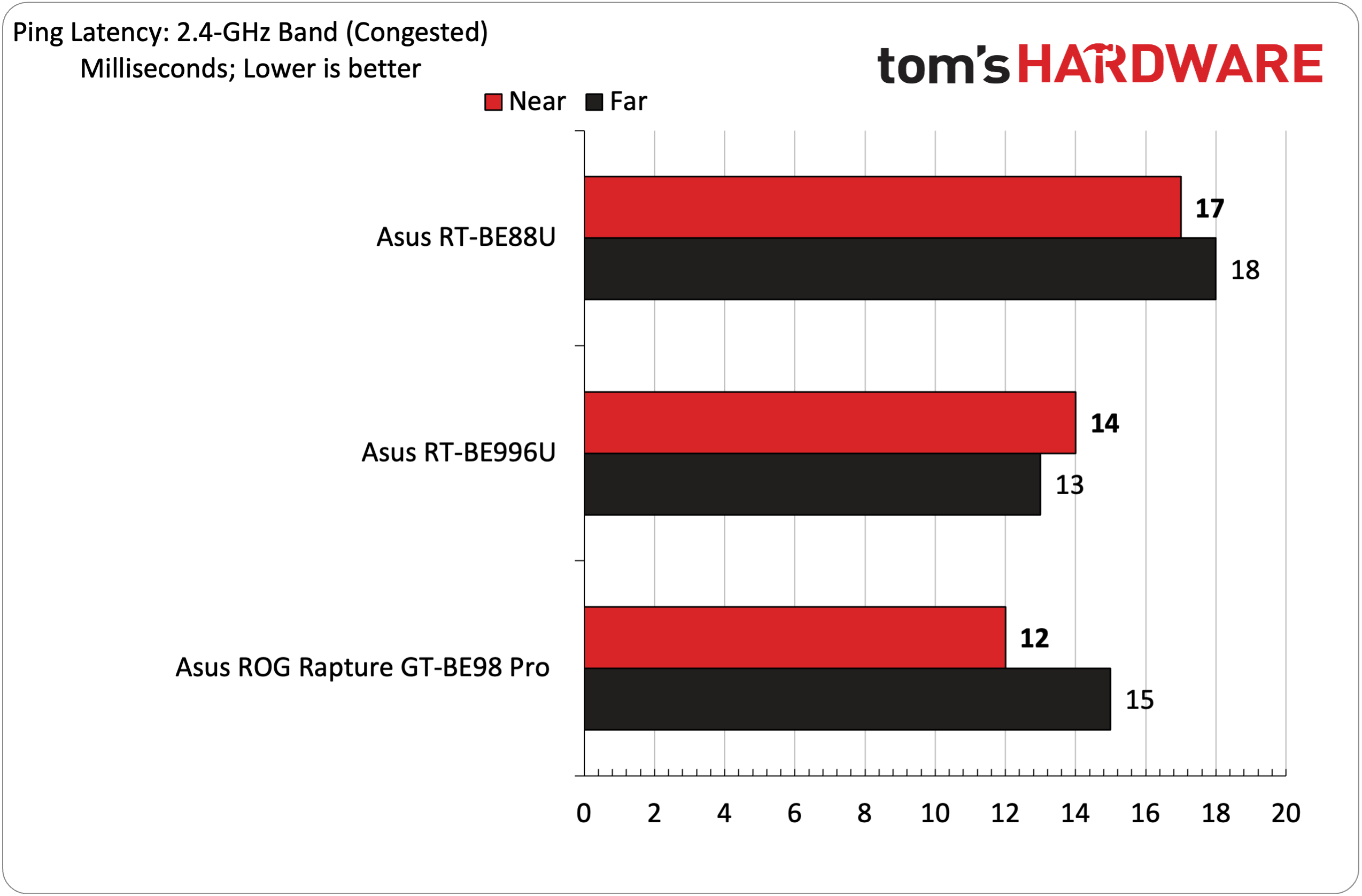
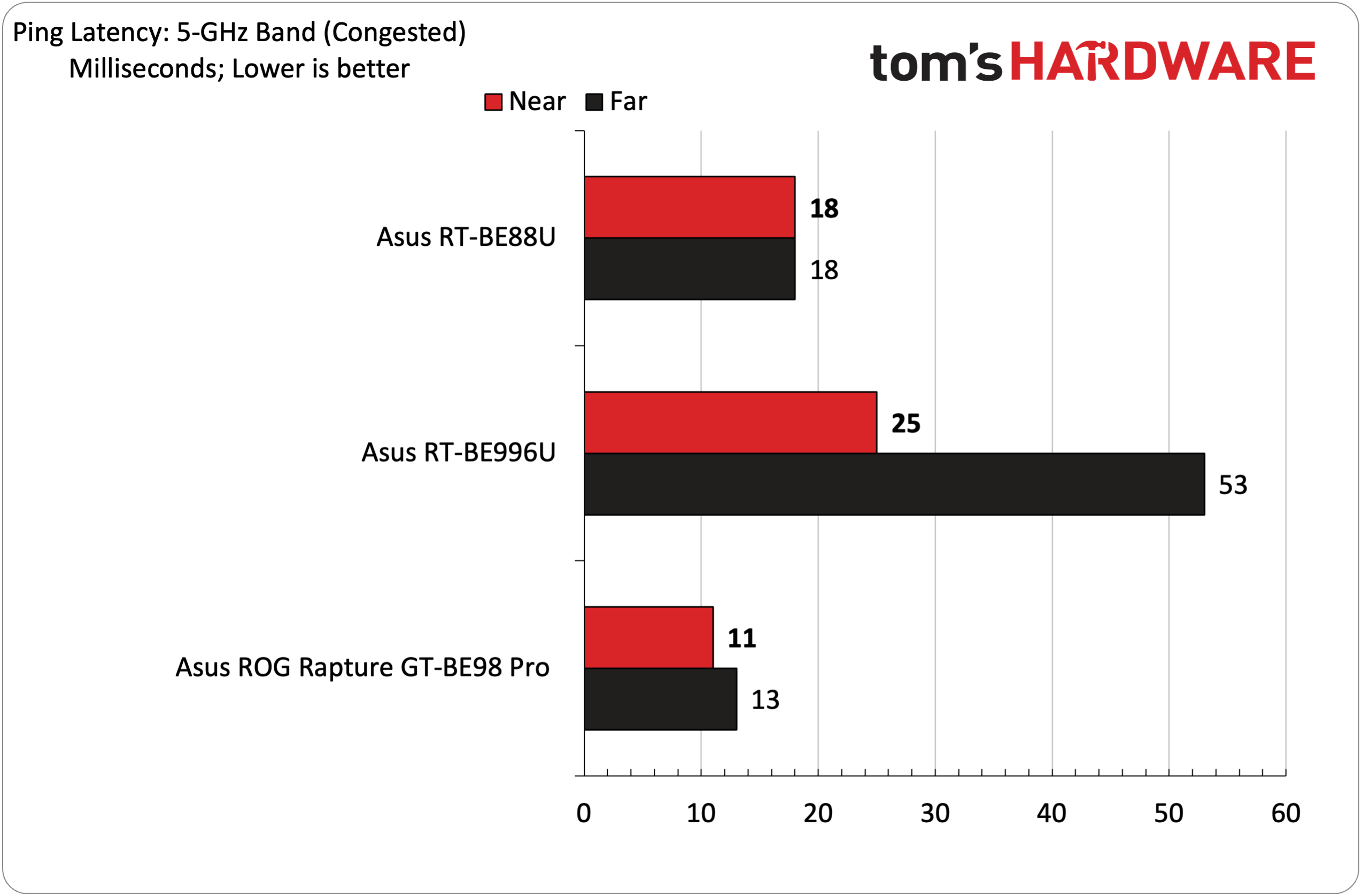
iPerf performance on the 5 GHz band was stellar, surpassing the 5 GHz performance of “true” Wi-Fi 7 routers like the Asus RT-BE96U and ROG Rapture GT-BE98 Pro. It topped 1.2 Gbps at six feet and fell to 958 Mbps at 25 feet. For reference, even the ROG Rapture GT-BE98 Pro could only manage 1.1 Gbps at six feet and dropped by half to 528 Mbps at 25 feet. With congested traffic, the RT-BE88U witnessed a 50 percent drop in throughput to 606 Mbps at six feet, then dropped by half again to 302 Mbps at 25 feet.
The RT-BE88U vastly underperformed its pricier WiFi 7 router siblings at 2.4 GHz in both congested and uncongested iPerf throughput tests. However, the performance drop going from six feet to 25 feet wasn’t as steep.
In most tests, ping times at six feet and 25 feet across congested and uncongested traffic were around 17 ms to 18 ms.
Bottom Line
The Asus RT-BE88U is an odd duckling in the Wi-Fi 7 router world. For those living in regions where the 6 GHz band is not viable or heavily restricted, it’s a viable modern solution. However, things become more complicated in areas where 6 GHz traffic is permitted, like the United States. Wi-Fi 6E introduced the 6 GHz band to wireless routers, and Wi-Fi 7 extended channel width to 320 MHz. The RT-BE88U can’t utilize that band, which puts it at a performance disadvantage.
Yes, 5 GHz performance is strong, but those with Wi-Fi 6E and Wi-Fi 7 clients who want to take advantage of all the performance benefits afforded by the new standard should take note. The RT-BE88U does have some positives, though, like its wealth of 1 GbE and 2.5 GbE ports. It also has two 10 GbE ports (one of which can be enabled via SFP+). It also is value priced with an MSRP of just $349 compared to $699 and $799 for the RT-BE96U and ROG Rapture GT-BE98 Pro, respectively.
However, that price advantage among Wi-Fi 7 routers isn’t guaranteed. For example, the TP-Link Archer BE800 has an MSRP of $599 and recently fell to just $350 during Amazon Prime Day. So bargain shoppers could score a full-fat Wi-Fi 7 router without compromise for the same price.

Brandon Hill is a senior editor at Tom's Hardware. He has written about PC and Mac tech since the late 1990s with bylines at AnandTech, DailyTech, and Hot Hardware. When he is not consuming copious amounts of tech news, he can be found enjoying the NC mountains or the beach with his wife and two sons.
-
Dementoss Too few people have the gear necessary to make use of 6GHz WiFi, so try to fix that moving up to 7GHz WiFi, which almost nobody can use yet...Reply
I'm wondering how that was seen to make sense, except as a means to fleece early adopters? -
Makaveli Reply
i'm siding on the fleecing.Dementoss said:Too few people have the gear necessary to make use of 6GHz WiFi, so try to fix that moving up to 7GHz WiFi, which almost nobody can use yet...
I'm wondering how that was seen to make sense, except as a means to fleece early adopters? -
kasala when did $350 become the threshold for "Value pricing" for a consumer orientated device?Reply -
Kondamin Reply
1 x10G Ethernet and the rest are 2.5Gkasala said:when did $350 become the threshold for "Value pricing" for a consumer orientated device?1
those still tend to be expensive.
Not that I don't agree with you it's much to expensive for that gimped wifi 7 -
usertests Reply
Wi-Fi 7 does not mean 7 GHz. There is no 7 GHz band available for Wi-Fi. It's a 6 GHz band with some channels near 7 GHz, but it's the same as Wi-Fi 6E:Dementoss said:Too few people have the gear necessary to make use of 6GHz WiFi, so try to fix that moving up to 7GHz WiFi, which almost nobody can use yet...
I'm wondering how that was seen to make sense, except as a means to fleece early adopters?
https://en.wikipedia.org/wiki/IEEE_802.11behttps://en.wikipedia.org/wiki/List_of_WLAN_channels#6_GHz_(802.11ax_and_802.11be)
There are small improvements in each standard that have nothing to do with the bands used or the headline top speeds. They probably don't help older devices though.
Wi-Fi 8 apparently adds bands around 42, 60 and 71 GHz for line-of-sight only. But it's not finalized yet. -
ThomasKinsley I must be spoiled rotten with ethernet because every time I see a router review, it's well over $200. Now $350 is considered a value buy.Reply -
67Matt99 Rather odd to be promoting something that isn't even widely available(7Ghz) to something (6Ghz) that it barely available and to call it a bargain price.Reply
Snake Oil! -
ukperson I have AC88U witch is no longer supported (by asus or merlin) so the BE88U is probably what I am going to get as it maybe let to do 1gbs over WiFi (seems to not have any problems, unlike the be92 and be98)Reply
